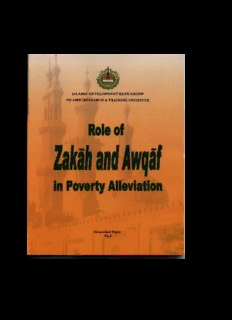
Role of Zakah and Awqaf in Poverty Alleviation PDF
Preview Role of Zakah and Awqaf in Poverty Alleviation
Islamic Development Bank Group Islamic Research & Training Institute Role of Zakah and Awqaf in Poverty Alleviation Habib Ahmed Occasional Paper No. 8 Jeddah, Saudi Arabia b © Islamic Development Bank, 2004 Islamic Research and Training Institute, King Fahd National Library Cataloging-in-Publication Data Ahmed, Habib Role of Zakat and Awqaf in Poverty Alleviation./ Habib Ahmed- Jeddah,2004-08-03 150 P; 17X 24 cm ISBN: 9960-32-150-9 1-Zakat 2-Endownments (Islamic fiqh) 3- Waqf I-Title 252.4 dc 1425/4127 L.D. No. 1425/4127 ISBN: 9960-32-150-9 The views expressed in this book are not necessarily those of the Islamic Research and Training Institute or of the Islamic Development Bank. References and citations are allowed but must be properly acknowledged First Edition 1425H (2004) . c ﻢﻴﺣﺮﻟﺍ ﻦﲪﺮﻟﺍ ﺍ ﻢﺴﺑ BISMILLAHIRRAHMANIRRAHIM d e CONTENTS List of Tables, Charts, Boxes, and Figures……………………….. 5 Acknowledgements..................................................................................... 9 Foreword……………………………………………………………………. 13 Executive Summary…………………………………………………… 15 1. Introduction…………………………………………………………… 19 1.1. Islamic View of Poverty……………………………………….. 20 1.2. Objectives of the Paper………………………………………… 23 1.3. Outline of the Paper……………………………………………. 23 2. Shari[ah and Historical Aspects of Zakah and Awqaf……... 25 2.1. Zakah and Awqaf in Shari[ah and Fiqh ……………………. 25 2.1.1. Zakah in Shari[ah and Fiqh………………………… 25 2.1.2. Awqaf in Shari[ah and Fiqh ………………………… 28 2.2. Historical Experiences of Zakah and Awqaf………………. 30 2.2.1. Historical Experiences of Zakah…………………….. 30 2.2.2. Historical Experiences of Awqaf…………………….. 32 2.3. Contemporary Resolutions on Zakah and Awqaf………… 35 2.3.1. Contemporary Resolutions on Zakah………………. 35 2.3.2. Contemporary Resolutions on Awqaf………………. 39 2.4. Zakah and Awqaf Institutions in Recent History…………. 41 2.4.1. Zakah Institutions in Recent History……………….. 41 2.4.2. Awqaf Institutions in Recent History……………….. 42 3. Dimensions of Poverty in the Muslim World……………… 45 3.1. Aggregate Economic and Welfare Information…………... 46 3.2. Poverty and Distribution of Income………………………… 49 1 3.3. Other Social Indicators ………………………………………... 51 4. Poverty and its Persistence: Causes, Solutions and the Role of Zakah and Awqaf……………………………………….. 55 4.1. Macro Dimensions of Poverty……………………………… 55 4.2. Micro Dimensions of Poverty………………………………… 58 4.3. Strategies for Poverty Alleviation…………………………… 60 4.3.1. Macroeconomic Policies that Induce Growth…… 60 4.3.2. Policies of Redistribution…………………………… 61 4.3.3. Capacity Building and Wealth Creation………….... 61 4.3.4. Income Support……………………………………….… 62 4.4. Poverty Reduction Strategies and the Role of Zakah and Awqaf…………………………………………………………………… 63 5. Poverty Alleviation through Zakah and Awqaf: Potentials and Scope……………………………………………………………… 65 5.1. The Potential of Zakah in Poverty Alleviation……………. 65 5.2. The Potential of Awqaf in Poverty Alleviation……………. 72 6. Zakah and Awqaf Institutions: Experiences from Selected Countries…………………………………………………. 77 6.1. Zakah and Awqaf Institutions in Malaysia………………… 77 6.1.1. Zakah Institutions in Federal Territory Kuala Lumpur………………………………………………………. 79 6.1.2. Zakah Institutions in the State of Negeri Sembelan……………………………………………………. 83 6.1.3. Zakah Institution in the State of Selangor…………. 86 6.1.4. Awqaf Institutions in Malaysia………………………. 90 6.2. Zakah and Awqaf Institutions in Pakistan........................... 91 6.2.1. Zakah Institutions in Pakistan ……………………… 92 2 6.2.2. Zakah Operations at the Federal Government Level…………………………………………………………. 93 6.2.3. Zakah in Islamabad Federal Territory……………… 95 6.2.4. Zakah in the Province of Punjab……………………….. 96 6.2.5. Awqaf Institutions in Pakistan……………………… 98 6.3. Zakah and Awqaf Institutions in South Africa ………… 101 6.3.1. Zakah Institutions in South Africa …………………. 102 6.3.2. Awqaf Institutions in South Africa………………….. 107 6.4. Summary of the Results………………………………………... 107 7. Zakah, Awqaf, and Poverty Alleviation: Assessments, Policies, and Institutional Development…………………….. 109 7.1. Integrating Zakah and Awqaf in the Overall Development Strategy………………………………………… 110 7.1.1. Zakah and the Overall Development Scheme…… 111 7.1.2. Awqaf and the Overall Development Scheme…….. 115 7.2. Laws and Regulations………………………………………… 116 7.3. Effective Organizational Structures for Zakah and Awqaf Institutions……………………………………………….. 119 7.3.1. Organizational Structure of Zakah Institutions…… 121 7.3.2. Organizational Structures of Awqaf Institutions…. 124 7.4. Institutional Development and Diversity…………………… 126 7.4.1. Zakah Collection Corporation……………………….. 126 7.4.2. Support and Insurance for the Vulnerable 127 7.4.3. Cash Waqf……………………………………………………… 127 7.4.4. Development of Waqf through Securitization…….. 128 7.4.5. Microfinance Institutions based on Zakah and Awqaf………………………………………………………… 129 7.4.6. Qard Hassan Banks…………………………………… 130 7.4.7. Insurance based on Waqf……………………………... 130 7.4.8. Agency/Institution for Development of Awqaf 3
Description: